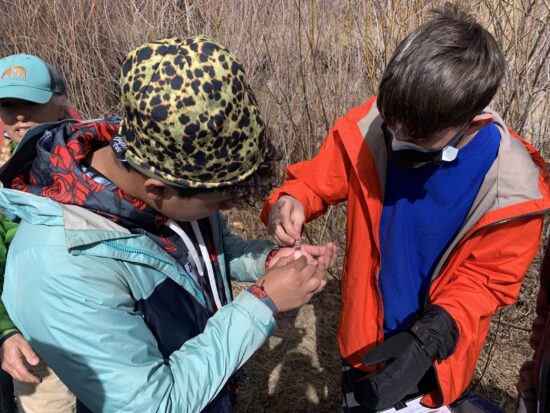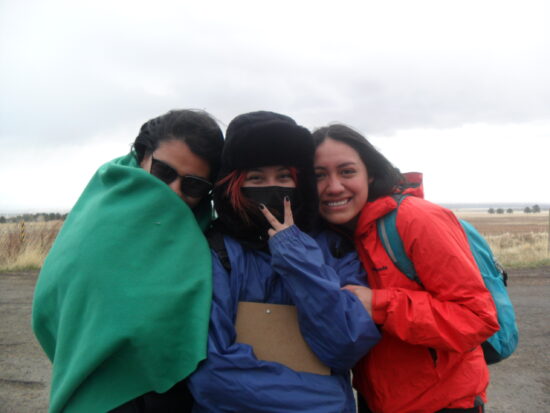
Read an update about Centaurus High School CAP Class’s water quality project on Coal Creek in Lafayette, CO. You can find the original article here.
Our Spring 2022 fire/water Coal Creek project all started with the students. Their primary interest was contaminación de agua – or water pollution. When explored further, the students’ overriding view of water pollution was plastic pollution in the ocean. This brought up lots of questions. We wondered how much our actions in Colorado would affect the ocean. We wondered if plastic pollution is the biggest threat to water quality, and why do we automatically think of plastic pollution when we think of contaminación?
Together we researched these questions and what to do about them. Along the way, we ran into articles about how wildfires can potentially affect water quality. The Marshall Fire had just happened and was on all our minds. We had an “aha moment” where we realized that we had a unique opportunity to do some hands-on research right in our community. The fire had burned all around our local creek. We realized that if we tested the water upstream above the burn site and down below the burn site, we may find evidence of the fire’s effects on water quality.
We reached out to the Watershed Coalition, CU Boulder, the cities of Lafayette and Louisville. We collaborated as much as we could with agencies and found a date and locations perfect for our water testing (being careful not to trample the endangered amphibian protection areas!).
We had an amazing day! Not only is the process of water testing and identifying and counting Benthic Macroinvertebrates super engaging in and of itself, but the knowledge that several entities, including the two city governments and the University of Colorado, are eager for this data and will be using it, is really gratifying. One student said, “I never knew that there were whole worlds within a drop of water!”
We found that so far the quality of water is still really good around Coal Creek. There were actually more benthic macroinvertebrates below the burn site. We hypothesized that that could be due to a lower elevation being more hospitable or that the macros were flourishing on the nutrients released by the fire. We had a data reveal at the City of Lafayette Earth Day Festival on April 30th. At our demonstration table, we taught people how to identify macroinvertebrates we had brought from the creek. We also had an eye-catching sculpture we created from trash collected along the creek.
We shared our data with the City of Lafayette Open Space and Parks department. They have asked that we keep testing and sharing data, so that our community can respond to any threats to water quality.
Nuestro proyecto de primavera 2022 Fuego/Agua comenzó con los estudiantes. Su principal interés era la contaminación del agua. Al profundizar en el tema, la perspectiva predominante de los alumnos sobre la contaminación del agua era la predominancia de la contaminación por plásticos en el océano. Esto nos hizo plantear muchas preguntas. Nos preguntamos hasta qué punto nuestras acciones en Colorado afectarían al océano. Nos preguntamos si la contaminación por plástico es la mayor amenaza para la calidad del agua y por qué pensamos automáticamente en la contaminación por plástico cuando pensamos en la contaminación.

Nos pusimos en contacto con la Watershed Coalition, la Universidad de Colorado en Boulder y las ciudades de Lafayette y Louisville. Colaboramos todo lo que pudimos con las agencias y encontramos una fecha y lugares perfectos para nuestras pruebas de agua (¡teniendo cuidado de no pisotear las zonas de protección de anfibios en peligro de extinción!)
¡Tuvimos un día increíble! No sólo el proceso de análisis del agua y de identificación y recuento de macroinvertebrados bentónicos es muy interesante en sí mismo, sino el hecho de saber que varias entidades, incluidos los dos gobiernos municipales y la Universidad de Colorado, están ansiosas por obtener estos datos y los utilizarán, es realmente gratificante. Un estudiante dijo: “¡No sabía que había mundos enteros dentro de una gota de agua!”.
Hemos comprobado que, hasta ahora, la calidad del agua sigue siendo muy buena en los alrededores de Coal Creek. De hecho, había más macroinvertebrados bentónicos debajo del lugar de la quema. Nuestra hipótesis es que eso podría deberse a que la elevación más baja es más hospitalaria o a que los macros estaban floreciendo con los nutrientes liberados por el incendio. El 30 de abril, en el Festival del Día de la Tierra de la ciudad de Lafayette, revelamos datos. En nuestra mesa de demostración, enseñamos a la gente a identificar los macroinvertebrados que habíamos traído del arroyo. También tuvimos una llamativa escultura que creamos con la basura recogida a lo largo del arroyo.
Compartimos nuestros datos con el departamento de espacios abiertos y parques de la ciudad de Lafayette. Nos han pedido que sigamos analizando y compartiendo los datos, para que nuestra comunidad pueda responder a cualquier amenaza a la calidad del agua.

